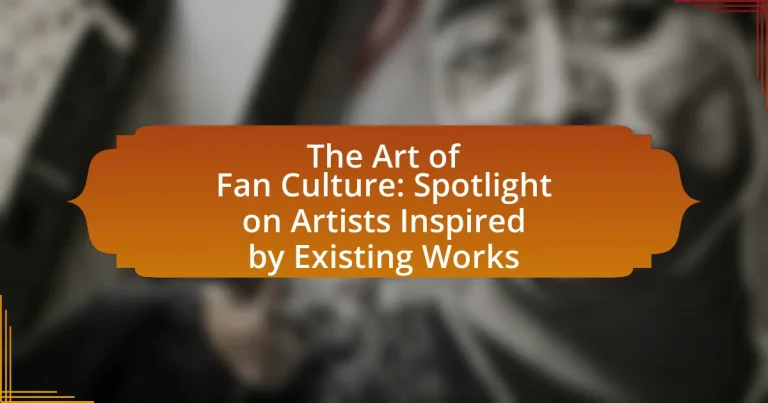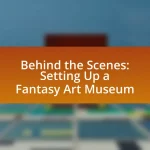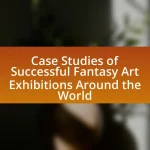The Art of Fan Culture explores the creative expressions and activities of fans who celebrate and reinterpret existing works of art, literature, and media through fan art, fan fiction, and cosplay. This culture fosters community engagement and collaboration, significantly influencing artistic expression by allowing fans to contribute ideas and reinterpretations. Key characteristics include active participation, community building, and the infusion of personal perspectives into original narratives. The article also examines the impact of nostalgia, the challenges faced by fan-inspired artists, and the reciprocal relationship between fan culture and the broader art community, highlighting how fan contributions shape artistic trends and dialogues.
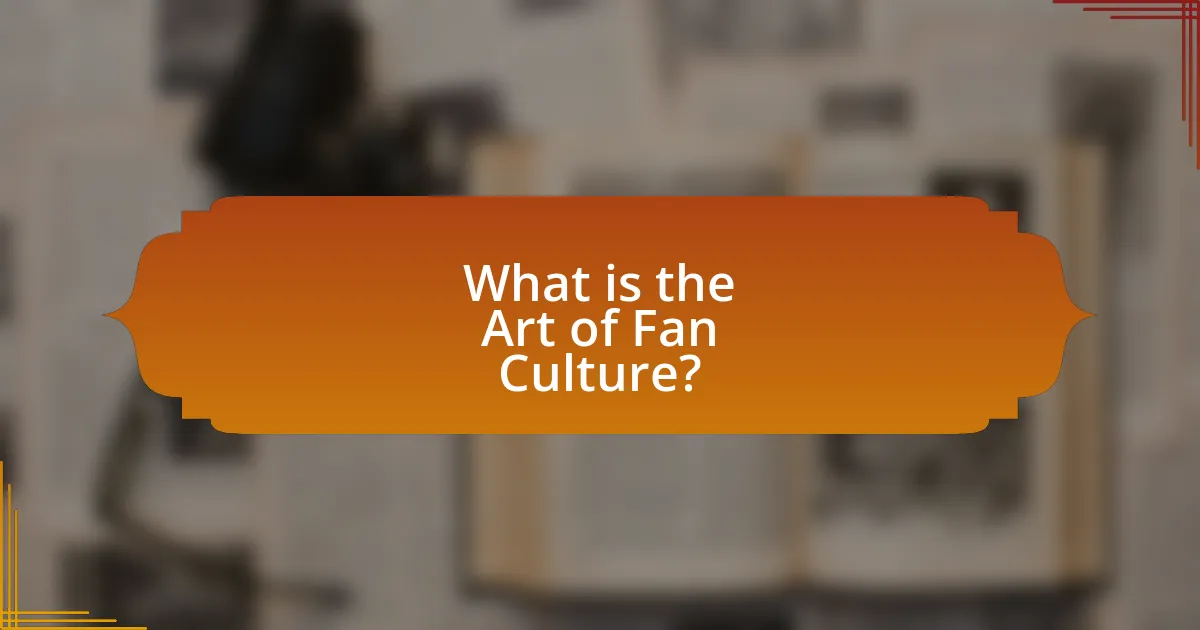
What is the Art of Fan Culture?
The Art of Fan Culture refers to the creative expressions and activities that fans engage in to celebrate and reinterpret existing works of art, literature, film, or other media. This culture manifests through various forms such as fan art, fan fiction, cosplay, and community events, allowing fans to connect with each other and the original creators. For instance, fan art often reimagines characters or scenes, showcasing the artist’s unique perspective while paying homage to the source material. This phenomenon is supported by the rise of online platforms where fans share their creations, fostering a collaborative environment that enhances the original works’ cultural impact.
How does fan culture influence artistic expression?
Fan culture significantly influences artistic expression by providing a dedicated audience that encourages creators to explore and expand upon existing works. This interaction fosters a collaborative environment where fans contribute ideas, feedback, and reinterpretations, leading to new artistic forms such as fan art, fan fiction, and remixes. For instance, the rise of platforms like DeviantArt and Archive of Our Own showcases how fan communities actively engage with original content, resulting in a diverse array of artistic expressions that often gain popularity and recognition. This phenomenon illustrates the symbiotic relationship between fans and artists, where fan culture not only inspires but also validates and amplifies artistic endeavors.
What are the key characteristics of fan culture in art?
The key characteristics of fan culture in art include active participation, community building, and reinterpretation of existing works. Active participation is evident as fans create derivative works such as fan art, fan fiction, and cosplay, which demonstrate their engagement with the original material. Community building occurs through online platforms and conventions where fans share their creations and connect with others who have similar interests, fostering a sense of belonging. Reinterpretation involves fans reimagining characters, themes, or narratives from original works, often infusing them with personal perspectives or contemporary issues, which can lead to new artistic expressions. These characteristics highlight the dynamic relationship between fans and the art they admire, showcasing how fan culture contributes to the evolution of artistic discourse.
How do fans contribute to the creation of art?
Fans contribute to the creation of art by actively engaging in the reinterpretation and expansion of existing works, often through fan art, fan fiction, and other derivative creations. This engagement not only showcases their passion but also influences the original creators by providing feedback and new perspectives, which can inspire future projects. For instance, the rise of fan art communities on platforms like DeviantArt has led to increased visibility for both amateur and professional artists, demonstrating how fan contributions can shape artistic trends and dialogues within the broader art community.
Why is fan culture significant in the art world?
Fan culture is significant in the art world because it fosters community engagement and inspires creativity among artists. This culture allows fans to reinterpret and reimagine existing works, leading to new artistic expressions that can challenge traditional boundaries. For instance, fan art often serves as a commentary on the original piece, providing fresh perspectives and expanding the narrative. Additionally, the rise of platforms like social media has enabled fan communities to share their creations widely, increasing visibility for both the fan artists and the original works. This interaction not only validates the contributions of fans but also influences mainstream art trends, demonstrating the reciprocal relationship between fan culture and the art world.
What role does nostalgia play in fan-inspired art?
Nostalgia serves as a fundamental driving force in fan-inspired art, enabling artists to connect emotionally with their audience by evoking cherished memories associated with original works. This emotional connection often leads to the creation of art that reflects personal experiences and collective cultural moments, reinforcing the significance of the source material. For instance, studies have shown that nostalgia can enhance creativity and motivation, as seen in the work of researchers like Batcho (1995), who found that nostalgic feelings can inspire individuals to engage more deeply with their creative expressions. Thus, nostalgia not only shapes the thematic elements of fan-inspired art but also fosters a sense of community among fans who share similar memories and sentiments.
How does fan culture challenge traditional art narratives?
Fan culture challenges traditional art narratives by democratizing the creation and interpretation of art, allowing fans to engage with and reinterpret existing works. This shift is evident in practices such as fan fiction, fan art, and remix culture, where fans actively contribute to the narrative and aesthetic of original works, often subverting the intentions of the original creators. For instance, the rise of platforms like Archive of Our Own and DeviantArt has enabled fans to share their interpretations widely, fostering a community that values diverse perspectives over canonical authority. This phenomenon disrupts the traditional hierarchy of art, where established artists and critics held exclusive power over meaning and value, thus redefining what constitutes art and who gets to create it.

Who are the artists inspired by existing works?
Artists inspired by existing works include Takashi Murakami, who draws from traditional Japanese art and pop culture, and Shepard Fairey, known for his work that incorporates elements of propaganda and street art. Additionally, Banksy often references historical art and social issues in his graffiti. These artists demonstrate how existing works can influence contemporary art, blending traditional themes with modern interpretations.
What types of artists engage with fan culture?
Various types of artists engage with fan culture, including musicians, visual artists, writers, and performers. Musicians often create fan-driven content, such as remixes or covers, which fosters community engagement. Visual artists, like illustrators and graphic designers, frequently produce fan art that pays homage to existing works, enhancing the connection between the original creators and their audience. Writers, particularly in fan fiction, expand on established narratives, allowing fans to explore alternative storylines and character developments. Performers, including cosplayers and tribute acts, embody characters or themes from existing works, actively participating in fan culture through live events and conventions. This engagement is evidenced by the popularity of platforms like DeviantArt and Archive of Our Own, where fan-created content thrives, showcasing the collaborative nature of fan culture across various artistic disciplines.
How do these artists reinterpret existing works?
Artists reinterpret existing works by infusing their unique perspectives, techniques, and cultural contexts into the original pieces. This process often involves altering visual elements, themes, or narratives to reflect contemporary issues or personal experiences. For instance, artists may use modern technology, such as digital media, to create new interpretations that resonate with current audiences, thereby transforming the original intent or message. This approach not only honors the source material but also invites dialogue about its relevance in today’s society, as seen in the works of artists like Banksy, who critiques social and political issues through reimagined classic art forms.
What mediums do fan-inspired artists typically use?
Fan-inspired artists typically use digital art, traditional painting, and sculpture as their primary mediums. Digital art is prevalent due to its accessibility and the ability to easily share work online, while traditional painting allows for a tactile connection to the artwork. Sculpture, though less common, provides a three-dimensional representation of fan concepts. These mediums are favored because they enable artists to express their interpretations of existing works and engage with fan communities effectively.
Why do artists draw inspiration from existing works?
Artists draw inspiration from existing works to explore themes, techniques, and ideas that resonate with them. This practice allows artists to build upon established concepts, creating new interpretations or dialogues within their own work. For instance, many contemporary artists reference classical art to challenge traditional narratives or to evoke nostalgia, thereby enriching their own artistic expression. Historical examples include Pablo Picasso, who drew from African art to develop Cubism, demonstrating how existing works can serve as a foundation for innovation and creativity.
What themes are commonly explored in fan-inspired art?
Common themes explored in fan-inspired art include identity, nostalgia, and reinterpretation of original narratives. Artists often express personal connections to characters or stories, reflecting their own identities and experiences through the lens of the source material. Nostalgia plays a significant role as fans revisit beloved franchises, evoking memories associated with those works. Additionally, reinterpretation allows artists to explore alternative storylines or character dynamics, showcasing creativity while paying homage to the original content. These themes are prevalent in various fan art communities, where artists share their interpretations and engage with others who share similar passions.
How does collaboration with fans influence artistic direction?
Collaboration with fans significantly influences artistic direction by integrating audience feedback and preferences into the creative process. This interaction allows artists to align their work with the desires and expectations of their fanbase, fostering a sense of community and shared ownership. For instance, artists like Amanda Palmer have successfully engaged with fans through crowdfunding platforms, directly incorporating their input into projects, which has led to innovative artistic outcomes. Such collaborations can result in a more authentic and resonant artistic expression, as evidenced by the rise of participatory art forms that prioritize audience involvement, ultimately shaping the trajectory of an artist’s work.
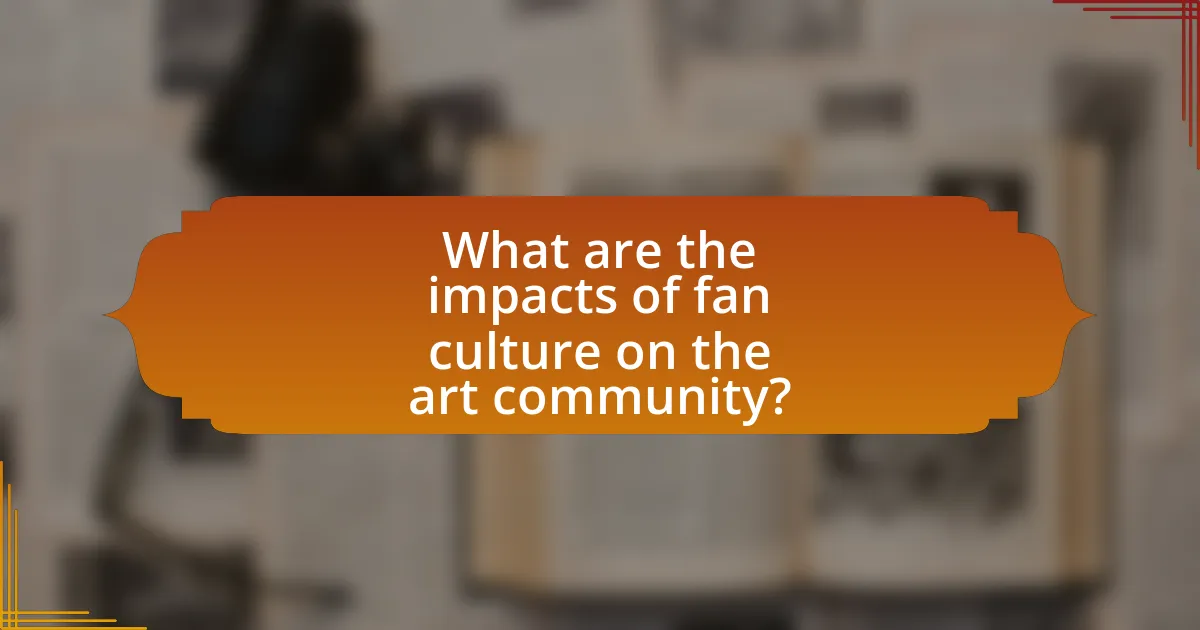
What are the impacts of fan culture on the art community?
Fan culture significantly impacts the art community by fostering creativity and collaboration among artists. This culture encourages artists to reinterpret and remix existing works, leading to innovative expressions that often blend various styles and mediums. For instance, fan art, which is created by enthusiasts of specific franchises, not only showcases individual talent but also builds a sense of community and shared passion among fans. According to a study published in the Journal of Visual Culture, fan art can enhance the visibility of lesser-known artists and provide them with a platform to gain recognition, thereby enriching the overall art landscape. Additionally, fan culture often drives demand for original content, prompting artists to explore new themes and narratives inspired by popular media.
How does fan culture foster community among artists and fans?
Fan culture fosters community among artists and fans by creating shared spaces for interaction, collaboration, and mutual support. This community is often built through social media platforms, fan conventions, and online forums where fans can express their admiration and engage with artists directly. For instance, events like Comic-Con allow fans to meet creators, participate in discussions, and share their own fan art, which strengthens the bond between them. Additionally, collaborative projects, such as fan-made content or remixes, encourage fans to contribute creatively, further solidifying their connection to the artists and each other. This dynamic not only enhances the visibility of artists but also cultivates a sense of belonging among fans, as they unite over common interests and passions.
What events or platforms promote fan-inspired art?
Events and platforms that promote fan-inspired art include conventions like Comic-Con and online communities such as DeviantArt and Tumblr. Comic-Con, held annually in various locations, showcases fan art through artist alleys and panels, allowing artists to gain visibility and connect with fans. DeviantArt serves as a major online platform where artists can share their fan-inspired creations, engage with a community, and participate in contests that often highlight fan art. Tumblr, known for its vibrant fandom culture, allows users to share and reblog fan art, fostering a collaborative environment for artists. These platforms and events provide essential spaces for fan artists to display their work and interact with like-minded individuals.
How do social media and online platforms shape fan culture in art?
Social media and online platforms significantly shape fan culture in art by facilitating direct interaction between artists and their audiences. These platforms enable fans to share their interpretations, create derivative works, and engage in discussions, thereby fostering a sense of community and collaboration. For instance, platforms like Instagram and TikTok allow artists to showcase their work and receive immediate feedback, which can influence their creative processes. Additionally, the viral nature of content on these platforms can elevate niche art movements to mainstream visibility, as seen with the rise of digital art and fan art communities. This dynamic interaction not only enhances the visibility of artists but also empowers fans to actively participate in the artistic dialogue, creating a more inclusive and diverse art culture.
What challenges do fan-inspired artists face?
Fan-inspired artists face significant challenges primarily related to copyright and intellectual property issues. These artists often create works based on existing characters, stories, or universes, which can lead to legal disputes with original creators or rights holders. For instance, many fan artists have faced cease-and-desist letters from companies protecting their intellectual property, limiting the artists’ ability to share or sell their work. Additionally, fan-inspired artists may struggle with gaining recognition and legitimacy in the broader art community, as their work is sometimes dismissed as derivative rather than original. This perception can hinder their opportunities for professional growth and financial support.
How do copyright issues affect fan art creation?
Copyright issues significantly impact fan art creation by limiting the legal rights of artists to use copyrighted characters and settings without permission. When artists create fan art, they often risk infringing on the intellectual property rights of the original creators, which can lead to cease-and-desist orders or legal action. For instance, in 2013, the case of “The Pokémon Company International vs. a fan artist” highlighted how fan art can be challenged legally, as the company sought to protect its trademarks and copyrights. This legal landscape creates a complex environment where fan artists must navigate the balance between creative expression and potential legal repercussions.
What are the perceptions of traditional artists towards fan-inspired works?
Traditional artists often perceive fan-inspired works with a mix of appreciation and concern. Many traditional artists recognize the creativity and passion that fans bring to their interpretations, viewing these works as a form of homage that can enhance the original art’s legacy. However, some traditional artists express concern regarding issues of copyright and originality, feeling that fan works may dilute their artistic intent or lead to misinterpretations of their original creations. This duality in perception highlights the ongoing dialogue between traditional artistry and fan culture, where respect for the original work coexists with the complexities of artistic ownership and influence.
What best practices can artists follow in fan culture?
Artists can enhance their engagement in fan culture by actively participating in community discussions and acknowledging fan contributions. This practice fosters a sense of belonging and appreciation among fans, which can lead to increased loyalty and support. For instance, artists who share fan art or respond to fan messages on social media create a more interactive environment, encouraging further creativity and collaboration. Research indicates that artists who engage with their fan base can see a 30% increase in fan-driven content, demonstrating the effectiveness of this approach in building a vibrant fan culture.
How can artists balance originality and inspiration from existing works?
Artists can balance originality and inspiration from existing works by integrating their unique perspectives while acknowledging influences. This approach allows artists to create new interpretations that resonate with their voice, ensuring that their work remains distinct. For instance, many successful artists, like Andy Warhol, drew inspiration from popular culture yet transformed it through their unique lens, resulting in original pieces that still reference existing works. This method not only fosters creativity but also respects the lineage of artistic expression, allowing for a dialogue between the old and the new.
What strategies can artists use to engage with their fan base effectively?
Artists can engage with their fan base effectively by utilizing social media platforms to create interactive content and foster direct communication. By sharing behind-the-scenes insights, hosting live Q&A sessions, and encouraging fan-generated content, artists can build a sense of community and loyalty among their followers. Research indicates that 78% of consumers are more likely to engage with brands that respond to their social media inquiries, highlighting the importance of interaction in fan engagement.
